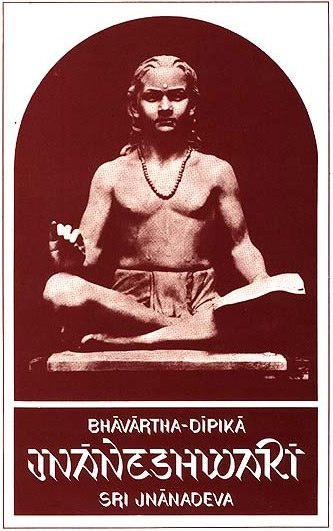Jnaneshwari (Bhavartha Dipika)
by Ramchandra Keshav Bhagwat | 1954 | 284,137 words | ISBN-10: 8185208123 | ISBN-13: 9788185208121
This is verse 18.52 of the Jnaneshwari (Bhavartha-Dipika), the English translation of 13th-century Marathi commentary on the Bhagavad-Gita.—The Dnyaneshwari (Jnaneshwari) brings to light the deeper meaning of the Gita which represents the essence of the Vedic Religion. This is verse 52 of the chapter called Moksha-sannyasa-yoga.
Verse 18.52
Verse 18.52: “Betaking himself to sequestered spot, with frugal fare, and restraining speech, body and mind, ever engaged in concentred meditation, and finding repose in freedom from passion. (1022)
Commentary called Jnaneshwari by Jnaneshwar:
He abandons buzzing and inhabited localities and dwells in solitude in woods, making the body and the organs his associates. He sports in sense-restraint and comprehensive self-governance, while his talk consists of observing strict silence. He finds no time for doing other things, being all along engaged in meditating upon the precepts of the preceptor. He never bestows any thought, while taking his meal, on making his physique strong, or satisfying his hunger, or satisfying the peculiar taste of his tongue (palate); but the contentment he feels, with only the frugal fare, is beyond measure. He takes food just sufficient to sustain life, weakened by heat created by abstinence from food. He gives no scope (seating accommodation) to either the slumber or indolence, in the way a respectable lady does not even turn her eye to a man (who is not her husband) and who expresses (by signs) carnal desires for her.
The only occasion when his entire body comes in contact with the floor is when he prostrates his body (in salutation). Except on such occasions, he seldom commits the wanton act of rolling on the floor. He allows the movements of his hands and feet only to the extent necessary for carrying on bodily functions. In short he keeps his body under complete control in and out. He does not allow his internal proclivities even to reach the threshold of the mind (i.e. they do not rise to the plane of consciousness); what then of giving them scope to manifest themselves in words? He thus conquers in and out the entire (psychic) atmosphere surrounding the body, speech and mind and then he grasps in his hand the very sky (sentience) in the form of concentrated meditation. He ever beholds before him, as one does one’s face in a mirror, his resolve of attaining the realization of the Self, awakened through the advice of the preceptor, and keeps always looking at it minutely.
The meditator himself though he be, the meditation as also the object of meditation, get united in his heart. The meditation continues till all the three—the meditator, the meditation, and the object of meditation—become one there, Oh Son of Pandu. Therefore the seeker becomes expert in the knowledge of the Self; yet this he secures because of his taking to the school of Yogic Study. He forms the posture Mulabandha, Oh Dhananjaya, by pressing his right (foot) heel against the seam, at a point midway between the two lower outlets (gudaśiśnarandhradvaya[?]—the anus and the penis).
Drawing in this way the lower region, and controlling properly the three Mudras (Physicomental postures) i) Mulabandha (mūla-bandha), ii) Uddiyana (oḍhīyāṇa[uḍḍiyāṇa?]-bandha) and iii) Jalandhar-bandha (jālandara-bandha), he brings together in one place the life-winds (normally scattered in different localities).
The power ‘Kundalini’ (kuṇḍalinī) then is aroused (becomes active) while the way to Madhyama, also called Sushumna (suṣumnā) the particular passage in a human body said to lie between ‘Ida and Pingala’ (iḍā-piṅgalā—two other air-passages in the body), is made clear and widened and then the life-winds rise and ascend up, piercing through all the six wheels viz. from the Muladhara to the Ajani (agni).[1]
Then there descend from the cloud in the form of the thousand-petalled lotus (sahasradalācā-meghū[?]) (in the region of Brahmarandhra in the seventh wheel) copious showers of ambrosia which flow down straight and reach Mulabandha. Thus he, the seeker, serves on a plate cooked food of mixed com (rice and pulse) in the form of the mind and the life-winds, to the terrible deity of sentience (cid-bhairava) dancing on the mountain (Kailas) in the form of the region of the Brahmarandhra. (Brahmarandhra—an aperture in the crown of the head through which the soul is said to escape on his leaving the body). In this way, he makes his seat of meditation strong and firm in the rear, keeping in front a big army in the form of perfection in (the study of) Yoga already secured. He has already secured in asceticism, a friend to aid him in keeping free from any obstruction, the meditation and the Yogastudy, and firmly training them in the knowledge of the essence of the self, and that friend asceticism always stands by him (the seeker) in the process of the occupation of the entire field.
When there is available the lamp light as far as the eye could reach to see a thing, where should then there be any delay in discerning that desired thing? In that way, one seeking liberation, with the heart completely absorbed in the essence of Supreme Brahman, and asceticism also sticking on to him throughout, in the case of such a one how could there arise a breach in his union with Supreme Brahman? Therefore, that fortunate one, who, attains the (study of) Yoga, accompanied by asceticism becomes qualified to the attainment of Supreme Self. Such a one donning the steel armour of asceticism on his person and riding the horse of Rajayoga, and holding in his clenched fist the sharp sword in the form of meditation, capable of cleaving clean every obstacle, big or small, coming in his way, enters, as the Sun enters into the darkness, into the battlefield of worldly affairs, in order to wed the Goddess of Victory in the form of emancipation.
Footnotes and references:
[1]:
For these Wheels and Chakras see—verse 37, Ch. VI. footnotes.
